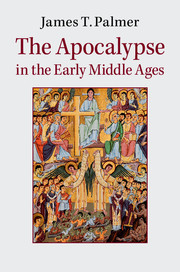Book contents
- Frontmatter
- Dedication
- Contents
- List of figures
- List of maps
- Acknowledgements
- List of abbreviations
- Maps
- Introduction
- 1 The end of civilisation (c. 380–c. 575)
- 2 The new urgency (c. 550–c. 604)
- 3 The ends of time and space (c. 600–c. 735)
- 4 Pseudo-Methodius and the problem of evil (c. 680–c. 800)
- 5 Charlemagne, pater Europae (c. 750–c. 820)
- 6 A Golden Age in danger (c. 820–c. 911)
- 7 The Year 1000 and other apocalypticisms (c. 911–c. 1033)
- Conclusion
- Select bibliography
- Index of manuscript references
- General index
- References
2 - The new urgency (c. 550–c. 604)
Published online by Cambridge University Press: 05 November 2014
- Frontmatter
- Dedication
- Contents
- List of figures
- List of maps
- Acknowledgements
- List of abbreviations
- Maps
- Introduction
- 1 The end of civilisation (c. 380–c. 575)
- 2 The new urgency (c. 550–c. 604)
- 3 The ends of time and space (c. 600–c. 735)
- 4 Pseudo-Methodius and the problem of evil (c. 680–c. 800)
- 5 Charlemagne, pater Europae (c. 750–c. 820)
- 6 A Golden Age in danger (c. 820–c. 911)
- 7 The Year 1000 and other apocalypticisms (c. 911–c. 1033)
- Conclusion
- Select bibliography
- Index of manuscript references
- General index
- References
Summary
As the first Year 6000 (= c. AD 500) passed further into the distance, apocalyptic tradition continued to evolve, but not always predictably. Augustine’s prohibitions against predictive calculations and literalism had little of the calming effect he might have hoped for, even as his works became increasingly central to Western theology after the Council of Orange (529). The many and varied reasons reflect both the creativity of Christian culture and the shifting fates and fortunes of communities across Europe. Few could face the ravages of the Justinianic plague, particularly strong between 542 and 590, without fear – and indeed it concentrated the minds of two key figures, Pope Gregory the Great (pope 590–604) and Bishop Gregory of Tours (bishop 573–94). There were other revolutions taking place too which reorientated the relationships between Christendom, empire, identity and social structure, necessarily undermining the initial logic of Augustine’s ideas in the process. The distance between imperial and Christian identity in the West began to seem natural and therefore also somehow ambiguous and intangible, as the reality of imperium was increasingly less important than its imagined ideal. As the arguments of Augustine, Jerome and others were applied to changed times, the force and logic of their ideas changed.
- Type
- Chapter
- Information
- The Apocalypse in the Early Middle Ages , pp. 55 - 78Publisher: Cambridge University PressPrint publication year: 2014



